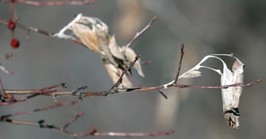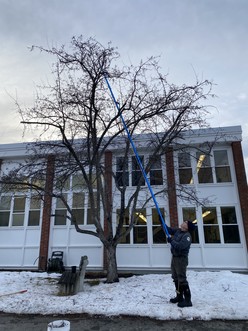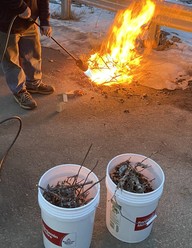Browntail Awareness Month - A Success!
Thank you for joining us this month to raise awareness and take action to reduce browntail moth impacts!
Browntail Moth Awareness Month may be over, but that doesn't mean browntail winter webs are gone!
Remove browntail webs before the end of March.
If you haven't already removed browntail winter webs from your property, make plans to remove the webs before the end of March while the rash-causing caterpillars are still inside and the trees are still dormant. You can recruit help from a licensed arborist or an FAA certified commercial remote pilot with a specialized vehicle to remove webs out of your reach.
Winter web removal in April will be less effective because caterpillars will have emerged from the webs by this time. Additionally, cutting webs will be more stressful for your trees. Pruning injuries can be more damaging in early spring due to sap flow and insect and pathogen activity. The USDA Forest Service guide to pruning trees is an excellent resource for information on pruning trees and shrubs.
If web removal isn't possible due to the height or quantity of winter webs, now is the time to recruit a licensed pesticide applicator who can treat trees in early spring to kill the caterpillars.
Still need help recognizing browntail winter webs?
- Stand with the sun to your back and check out browntail's favorite host trees (oak, elm, birch, poplar, cherry, fruit and ornamentals). Look at the tips of branches for palm-sized webs wrapped tightly in white silk. The silk will reflect the sun and differentiate these current webs with older browntail webs or unfallen leaves (no silk reflection).
- If you find current browntail webs, focus treatment on trees closest to your house and in high traffic areas such as your dooryard.
Knowing where browntail winter webs are on your property and which trees have the most webs can help inform your management decisions; whether you do it yourself or recruit professional assistance.

We used the Four Rs to Knock Out Browntail at a Community Clipping Event!
|
A concerned parent and local realtor recognized browntail winter webs at the RSU 26 campus by looking at the tips of the branches for palm-sized webs wrapped tightly to the branch with white silk.
She reached out to her School IPM Coordinator, her town, and Maine Forest Service (MFS) to volunteer to host a community event.
|
|
 |
 |
|
Members of MFS, Town of Orono, UMaine Cooperative Forestry Research Unit, Better Homes and Gardens Masiello Group, and the public removed over 100 browntail winter webs (conservatively, that's over 5,000 caterpillars!) at a community clipping event at the RSU campus 26 in 2023.
Photo credit: Megan Hess, Orono Public Works
|
|
After collecting all of the clipped browntail winter webs from the 2023 community clipping event, members from Orono Public Works burned the webs to prevent caterpillars from emerging and reinfesting trees. This type of activity requires a free burn permit from the State of Maine. An alternative option to destroy the webs is to soak the webs in soapy water for a few days and throw them out in the trash.
Photo credit: Megan Hess, Orono Public Works
|
|
 |
After web removal, we all enjoyed hot cocoa and encouraged everyone to:
-
Recruit professional help from licensed arborists and licensed pesticide applicators if winter web removal on their own properties isn't possible, and
-
Reach out to their neighbors, businesses, and town members if they find browntail winter webs in their neighborhood, downtown, or places they work. The more people we can get involved to recognize and remove browntail moth, the better the results.
DACF Calendar Events:
Now through March 10, 2023, 12:00 PM
The MFS is developing rules for administering browntail moth mitigation funds. A second round of public comment is currently open for the proposed rules.
The Fund was created to provide funding to government entities or nonprofit organizations to support the mitigation of browntail moth in areas of Maine with significant populations. The draft rule includes details on the types of organizations that can apply for funds, the application process, the types of activities that could be funded, and how funds will be disbursed.
The public comment period will close on March 10 at 12:00 PM. Comments should be submitted to Allison Kanoti, MFS.
March 17, 2023, 11:00 AM (Tentative)
Cost: Free
Location: Radio & Online
MFS Entomologists Tom Schmeelk and Allison Kanoti, Maine CDC's Megan Porter, and State Representative Allison Hepler will be among the guests engaging in conversation with show hosts and listeners about browntail moths on an upcoming episode of Maine Calling.
March 2023
Cost: Free
Location: Your neighborhood!
Host your own neighborhood event! Some ideas for activities include mapping infestations on the town and public properties, hosting public service web-clipping events, creating contests for the most webs clipped or other community, and knowledge building activities. Use #KnockOutBTM on social media! It's a great way to stay in touch with your community during the winter season, and it's an even better way to reduce browntail populations to protect you, your family, and your neighbors.
For more information:
Visit the Maine Forest Service webpage, explore the resources, and subscribe to news bulletin topics. Review and share news and events, FAQs, and management techniques. Test the BTM interactive map and read the latest research.
|